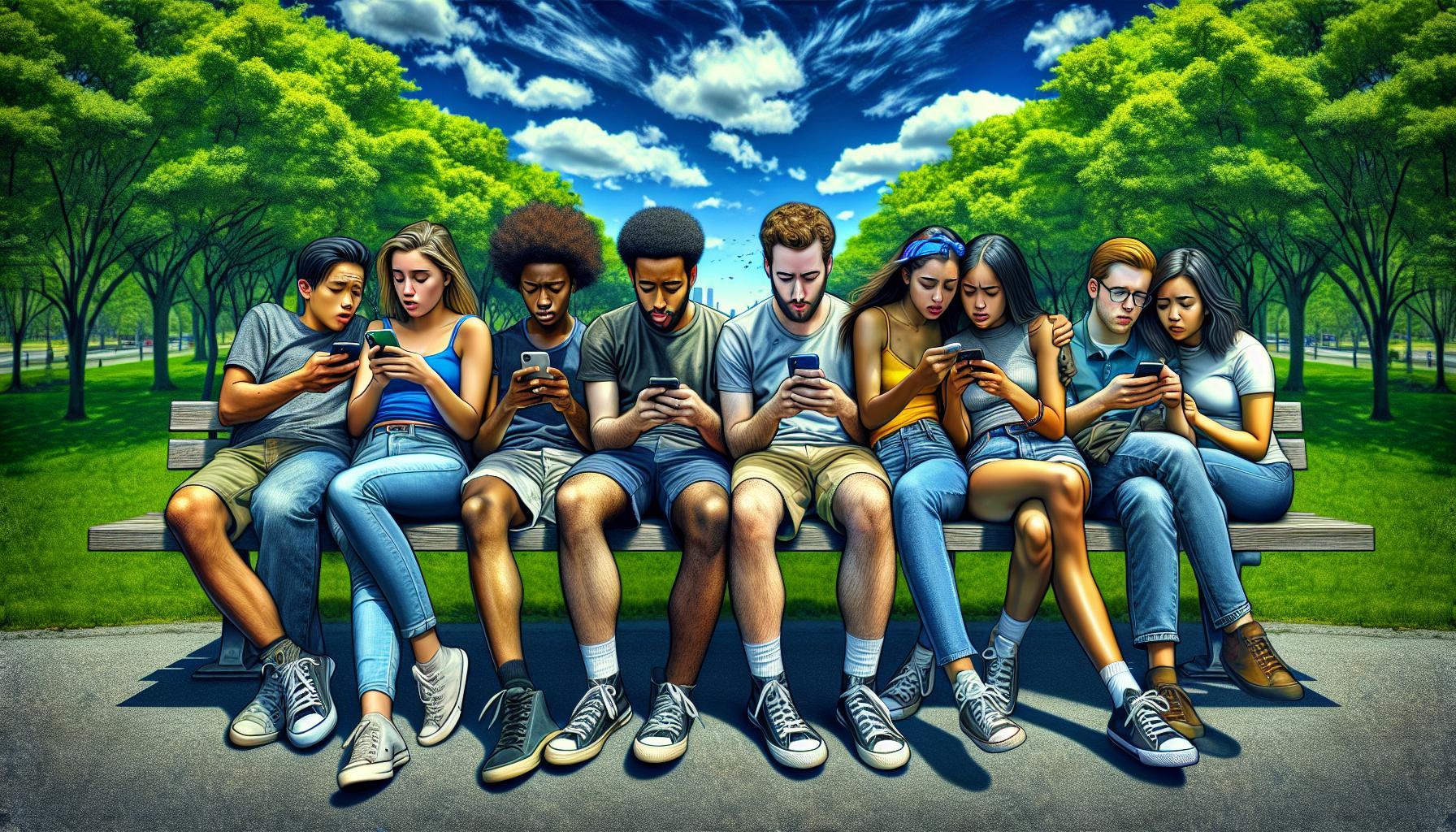Key Takeaways
- Significant Risks: Social media can negatively impact youth mental health, self-esteem, and overall well-being, leading to anxiety, depression, and body image issues.
- Cyberbullying Threats: Approximately 20% of adolescents experience cyberbullying, which can have severe emotional consequences, including increased anxiety and depression.
- Privacy Concerns: Many young users share personal information without understanding the risks, exposing themselves to dangers like stalking and identity theft.
- Sleep Disruption: Increased screen time from social media significantly affects sleep quality, with many teens losing 1-2 hours of sleep each night.
- Healthy Usage Awareness: Educating youth about responsible social media use, privacy settings, and healthy sleep habits is vital for fostering well-being in the digital age.
Social media has transformed the way young people connect and communicate, but it comes with significant risks. As teens dive into the digital world, they often encounter challenges that can impact their mental health, self-esteem, and overall well-being. The allure of likes and shares can lead to unhealthy comparisons and cyberbullying, creating an environment that’s far from supportive.
Moreover, the constant exposure to curated lives can distort reality, making it difficult for youth to navigate their own identities. With privacy concerns and the potential for addiction, understanding these dangers is crucial for parents, educators, and the young users themselves. Awareness can empower them to use social media responsibly while fostering a healthier relationship with technology.
Understanding Social Media
Social media encompasses digital platforms that facilitate interactions, content sharing, and networking among users. Understanding its definition and popular platforms is crucial when evaluating its impact on youth.
Definition and Popular Platforms
Social media refers to websites and applications that enable users to create and share content or participate in social networking. Key platforms include:
- Facebook: A platform for connecting with friends, sharing updates, and joining groups. With 2.9 billion monthly active users, it remains one of the most widely used platforms.
- Instagram: Focuses on photo and video sharing with more than 1.4 billion active users. It emphasizes aesthetic content, influencing self-image.
- Twitter: A microblogging platform that allows users to post short messages. It has 450 million monthly active users, facilitating real-time conversation and news dissemination.
- TikTok: A short-video platform, popular among youth, with about 1 billion active users. It enables creative expression through music and visual content.
- Snapchat: Offers ephemeral messaging and multimedia sharing. With 347 million daily active users, it attracts younger demographics through unique communication features.
Rise in Youth Usage
Youth usage of social media has surged significantly in recent years. According to recent studies, approximately 95% of adolescents possess a smartphone, which facilitates constant access to social media. Furthermore, statistics reveal that teens spend an average of 7 hours and 22 minutes daily on digital media, with a substantial portion dedicated to social media platforms. This relentless engagement raises concerns regarding mental health, privacy, and social skills, making it essential to understand the implications of such extensive usage.
Psychological Effects

Social media significantly impacts the psychological well-being of youth. Understanding these effects is essential in addressing the risks associated with social media use.
Anxiety and Depression
Anxiety and depression rates among youth often correlate with social media interactions. Regular exposure to online content can lead to feelings of inadequacy and heightened stress. A study by the American Psychological Association reveals that adolescents frequently comparing themselves to others on platforms experience increased anxiety symptoms. Additionally, cyberbullying incidents contribute to depressive moods, exacerbating mental health issues. Youth engaging intensively on social media appear more vulnerable, with a 2019 survey indicating that 37% of teens report feeling sad or hopeless due to online experiences.
Body Image Issues
Body image issues in youth frequently arise from social media usage. Constant exposure to edited images and lifestyle portrayals fosters unrealistic beauty standards. Research conducted by the University of Pennsylvania indicates that young individuals spending more than three hours daily on social media platforms express dissatisfaction with their bodies. Girls are particularly affected, with 61% reporting feelings of self-consciousness about their appearance after viewing images online. This dissatisfaction can lead to unhealthy behaviors, including disordered eating habits, as they attempt to conform to perceived ideals.
Cyberbullying

Cyberbullying poses a significant threat to youth today, often leading to severe emotional and psychological consequences. It encompasses various forms of harassment via digital platforms, impacting teens’ wellbeing extensively.
Prevalence Among Youth
Cyberbullying affects approximately 20% of adolescents, according to the Cyberbullying Research Center. Many encounter derogatory comments, spreading of rumors, and social exclusion online. Social media platforms, where anonymity thrives, serve as primary channels for such behavior. A study revealed that 60% of young individuals witness cyberbullying in their peer groups.
Consequences of Cyberbullying
Consequences of cyberbullying extend beyond the virtual world, significantly affecting mental health. Victims often experience increased levels of anxiety, depression, and suicidal thoughts. Research indicates that youth involved in cyberbullying are more likely to engage in self-harm behaviors — studies show a 35% higher risk for victims. Additionally, academic performance may decline, with affected students exhibiting lower grades and higher absenteeism. The long-term effects can include difficulties in forming healthy relationships and ongoing mental health issues, underscoring the urgent need for effective intervention strategies.
Privacy Concerns

Privacy remains a significant issue for youth on social media platforms. The sharing of personal information and data security risks contribute to this growing concern.
Sharing Personal Information
Sharing personal information frequently occurs among youth on social media, often without a clear understanding of potential consequences. Many adolescents post details such as their full names, locations, and school names, exposing themselves to dangers like stalking and identity theft. The impulse to gain likes or followers can overshadow privacy considerations, as youth may fail to recognize that their profiles could attract unwanted attention from strangers. Educating young users on the importance of adjusting privacy settings and limiting personal information disclosure can mitigate these risks.
Data Security Risks
Data security risks significantly affect youth when interacting on social media platforms. Hackers often exploit vulnerabilities in these networks to gain access to personal accounts. Once compromised, these accounts can be used for malicious purposes, including harassment or financial fraud. Additionally, some platforms collect and sell user data, which can lead to targeted advertisements or even data breaches. A 2021 report indicated that nearly 50% of social media users experienced at least one type of data breach, emphasizing the need for stronger security measures and awareness among young users regarding protecting their online information.
Impact on Sleep
Social media significantly affects youth sleep patterns, contributing to sleep disruption and associated health issues. Increased screen time, especially before bedtime, leads to difficulties in falling asleep and maintaining a restful night.
Screen Time and Sleep Disruption
Screen time, particularly from social media platforms, reduces sleep quality among adolescents. Research shows that exposure to blue light emitted by devices interferes with melatonin production, a hormone crucial for sleep regulation. Higher usage rates reveal that 70% of teens report using electronic devices within an hour of going to bed, resulting in an average sleep loss of 1-2 hours each night. The constant notifications and engagement from social media can create a cycle of distraction, keeping teens awake longer and leading to fragmented sleep. Over time, insufficient sleep can result in fatigue, decreased academic performance, and impaired concentration during waking hours.
Importance of Healthy Sleeping Habits
Encouraging healthy sleeping habits is essential for youth well-being. Establishing a consistent sleep schedule, aiming for 8-10 hours of sleep nightly, can improve overall health. Engaging in relaxing activities before bedtime, such as reading or meditation, can also enhance sleep onset. Limiting screen time at least one hour before sleep helps mitigate adverse effects associated with social media. Fostering awareness around the importance of sleep can support better mental and physical health outcomes for adolescents, promoting a healthier lifestyle amidst the challenges posed by social media.
Dangers of Social Media
The dangers of social media for youth are significant and multifaceted. With mental health issues rising and privacy concerns becoming more prominent the need for awareness and proactive measures is crucial. Young people are navigating a complex digital landscape that can distort their self-image and expose them to harmful interactions.
Parents and educators play a vital role in guiding youth towards responsible social media use. By fostering open conversations about online experiences and encouraging healthy habits they can help mitigate the negative impacts. It’s essential to prioritize mental well-being and equip young users with the tools to navigate social media safely.